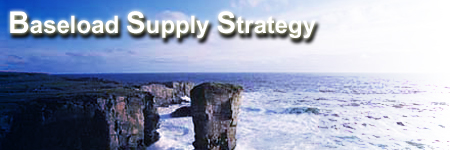


| Electricity Cost |
Approach Capital Costs Annual Costs Pumped Storage Costs Observations References
Approach
An economic analysis was undertaken to evaluate the electricity cost. In order to do this, an installation timetable was necessary. This enabled the amount of turbines installed each year to be quantified, and the yearly output from the scheme calculated in KWh. The yearly costs could then be calculated in terms of capital cost of installation, annual cost, and cost of pumped storage.
back to top
Capital cost
In order to calculate the capital for the turbines being installed in a year, it was first necessary to understand the relationship between capital cost and number of turbine units. The cost per unit would come down as sales increased and the items became cheaper to manufacture. There would also be economies of scale for ordering in large "wholesale" quantities. Referring to accounting literature, models of pricing behaviour were adapted to derive a price per marine current turbine based on quantity installed to date and quantity installed in a year. Original prices published by MCT and Binnie Black and Veatch consultants were used to provide the basis for this extrapolation (figure for 1 unit, 5 units and 30 units given).
This unit price, dependent on number of units installed to date and scale of installation, could then be multiplied by the number of units installed in that year, to give the amount of the repayment loan required for that year.
The repayment period was chosen as 12 years, and the interest rate was set at 8% for the purposes of this evaluation. Loans were staged, so that the full cost of the project was not borrowed until the final year of installation (see below - £)

The same pattern could be observed at the end of the loan periods - the repayment of one loan was completed each year (after a 12 year period from the start of the first loan), having a subsequent positive impact upon the cost of electricity. However, it should be noted that as the price of electricity begins to come down due to loan completion, the MCT devices may have reached an age at which they require extensive maintenance, refurbishment or decomissioning, and this expenditure will level the price of electricity once more (though this factor has not been included in this evaluation).
back to top
Annual cost
Annual costs include insurance, seabed rent and maintenance. Values for these were known for 1,5 and 30 units from an MCT/Binnie Black and Veatch Consultants study. From these figures, a linear extrapolation allowed reduction of the maintenance costs to take account of economies of scale (however this doesn't take into account the refurbishment costs mentioned in the previous section). Annual costs were calculated per unit, and then muliplied for the total number of units installed. Once installation was complete, this was assumed to be a constant figure for subsequent years.
back to top
Pumped storage cost
The pumped storage cost was calculated based on an assumption of £0.013 per KWhr (this was quoted by sources within the power station itself). This was used to multiply the storage used each year in order to account for this cost in the annual calculations. Some years had no pumped storage as the scheme was not complete in that particular year, and so it was more efficient to simply sell this electricity direct to the grid.
back to top
Observations
The cost of electricity from this study is surprisingly low - dropping from around 6 pence per kWhr in the earlier years of the both the minimum and maximum storage options. This could be due to a number of factors:
- Cost of pumped storage is too low
- Annual costs are not high enough - other factors need to be considered
- Installation costs may be more expensive than estimated by MCT
- Anticipated economies of scale may be over zealous
- Anticipated power outputs may be overly optimistic
Click on one of the links below to see scenario-specific results:
Minimum Storage (best baseload) Strategy
Maximum Storage (maximum output) Strategy
back to top
References
- Hangren, Foster and Daker (2000), Cost Accounting, Prentice Hall International.
- IC Eng (1988), A guide to Capital Cost Estimating, 3rd Edition, Institution of Chemical Engineers.
- Department for Education (1993), The Pickup Guide to Costing and Pricing, London, HMSO.